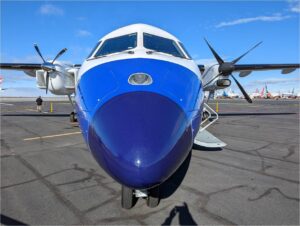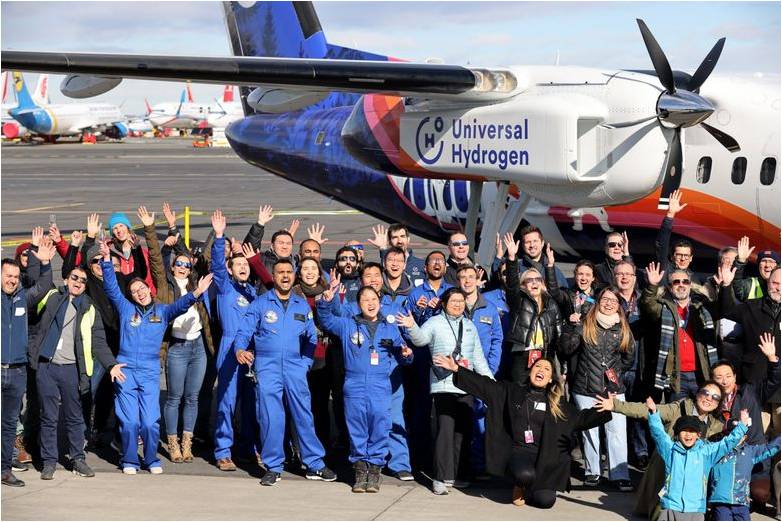Universal Hydrogen flew the largest hydrogen-powered aircraft yet at Grant County Airport in Moses Lake, Washington. The DeHavilland Dash 8 was powered on its right side by a MagniX motor and fueled by H2 from a pair of containers in the rear of the fuselage. It made a 15 minute flight to 3,500 feet and settled back to a safe landing
It carried “the largest hydrogen fuel cell ever to power an aircraft, “and Universal Hydrogen co-founder and CEO Paul Eremenko “declared the moment the dawn of a new golden age of aviation.”
Prep for flight
Lightning McClean, Universal’s modified Dash 8, normally flies with up to 50 passengers. The penalty for using H2 for fuel is giving up 10 of those revenue-producing seats, Universal’s Plug Power containers taking up the back rows of the cabin. Other gear included a rigorous evaluation of every component and system, the Dash 8 was ready for taxiing and test flights.

Dash-8 gives up a few seat to accommodate clean fuel
Two large hydrogen tanks held 30 kilograms (66 pounds) of fuel, of which only 10 kilograms (22 pounds) was used during the flight. Other components delivered H2 to the MagniX motor, and two racks of electronics and sensors monitored their operation.
Managing Power
Chief test pilot Alex Kroll, copilot Michael Bockler and an un-named engineer crewed the lop-sided craft with a much smaller five-blade propeller on the starboard motor than that on the regular turboprop engine on the port side. Despite the asymmetric appearance, Bockler said, “she flew just like a normal Dash 8, and the only thing we noticed was a little bit of yaw because of the differential in thrust.”
Takeoff started with full power on the Magni650 and only 40-percent on the Pratt and Whitney turboprop. After takeoff, the pilots reduced power on the PW127 and set the desired power on the Magni650. Bockler explained, “Then every 10 knots above 40 we added 10% –so 90 knots–90%, and at 100 knots we were at 100% power on the Pratt.”

One can’t help but notice the decidedly asymmetric difference in motors, propeller size and blade numbers
Power on the Magni650 is commanded by the torque output, which in turn commands the compressor and controls, according to Bockler.
Aviation Week reports, “The crew focused on monitoring temperature and the voltage output of the electric motor. Bockler explained, ‘The voltage was staying steady the whole time and we pulled the P&W engine back to 900 rpm to make it nice and quiet and showcase the electric engine.’ Although exact data is still being analyzed, the test crew believes as little as 10 kg of hydrogen was used over the 15-[minute flight.]”
Mark Cousin, Universal Hydrogen’s CTO Mark Cousin told TechCrunch that its fuel cell could run all day without overheating, thanks to its large air ducts.
According to the Spokane Spokesman-Review, “During the flight, Kroll throttled back the gas engine almost to idle so the plane cruised largely on the one hydrogen-powered engine under its right wing.
“’It feels like a normal airplane. You hardly know that the engine … has been modified,” said Kroll, a former U.S. Air Force pilot. ‘All the noise was coming from the left side. Once we hit cruise, we throttled back and we flew almost exclusively on the right-hand engine. It was silent.’”
The Spokesman-Review added another reassurance. “Universal’s modular tank has leak detection. If hydrogen leaks, the tank vents over a catalyst to turn the hydrogen to water.
“Eremenko showed a video of fire tests on a hydrogen-powered car, in which the hydrogen ignited and burned off harmlessly, compared with the outcome on a regular car that was engulfed in flames by pooling gasoline.”
“’Hydrogen is probably going to be safer than jet fuel,’ Eremenko said.”
Plug Power reported, “The fuel cell operated throughout the flight, generating up to 800kW of power and producing nothing but water vapor and smiles on the faces of a crowd of Universal Hydrogen engineers and investors.”
Eremenko praised the effort and offered a prediction. “We think it’s a pretty monumental accomplishment. It keeps us on track to have probably the first certified hydrogen airplane in passenger service.”
MagniX’ Contribution
So far, MagniX has been a major contributor to the electric aviation flights at Moses Lake. Their Cessna Caravan flew there in mid-2020 on battery power, followed in late 2022 by Eviation’s Alice, also MagniX powered.
Universal Hydrogen is even now preparing an ATR72 in Toulouse, France for an even bigger demonstration of what electric motors fueled by hydrogen can do. With others such as ZeroAvia and Airbus exploring H2 power, we should see a flourishing series of test flights on the near horizon.

